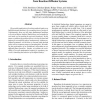Free Online Productivity Tools
i2Speak
i2Symbol
i2OCR
iTex2Img
iWeb2Print
iWeb2Shot
i2Type
iPdf2Split
iPdf2Merge
i2Bopomofo
i2Arabic
i2Style
i2Image
i2PDF
iLatex2Rtf
Sci2ools
EH
2004
IEEE
2004
IEEE
How to Evolve the Head-Tail Pattern from Reaction-Diffusion Systems
The possible application of evolving artificial embryos to build functional machinery is a promising area of research. Unfortunately, there are still many fundamental problems to be solved before Artificial Embryology can be applied to such tasks, not to mention the necessary hardware. In this paper we address the problem of how to evolve the head-tail pattern for an artificial embryo endogenously, without predefined asymmetric cell division or external guide through polar cells or exogenous sources of morphogenes. We examine the performance of an Evolutionary Algorithm on two different fitness functions. Further, we examine the evolvability of several mathematical models for regulatory networks, controlling the behavior of the digital embryo.
| Added | 20 Aug 2010 |
| Updated | 20 Aug 2010 |
| Type | Conference |
| Year | 2004 |
| Where | EH |
| Authors | Felix Streichert, Christian Spieth, Holger Ulmer, Andreas Zell |
Comments (0)

